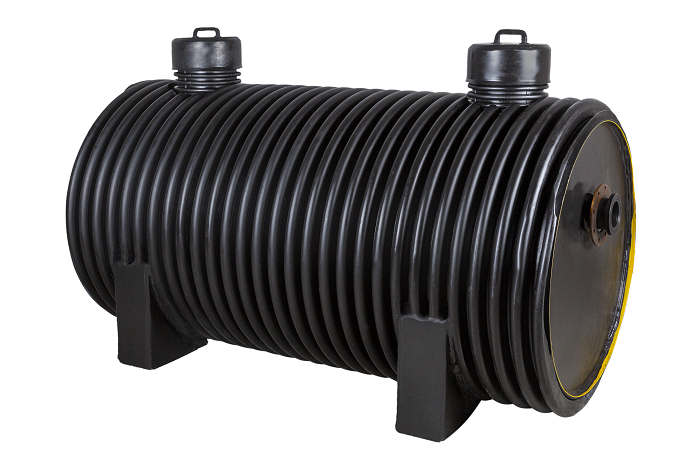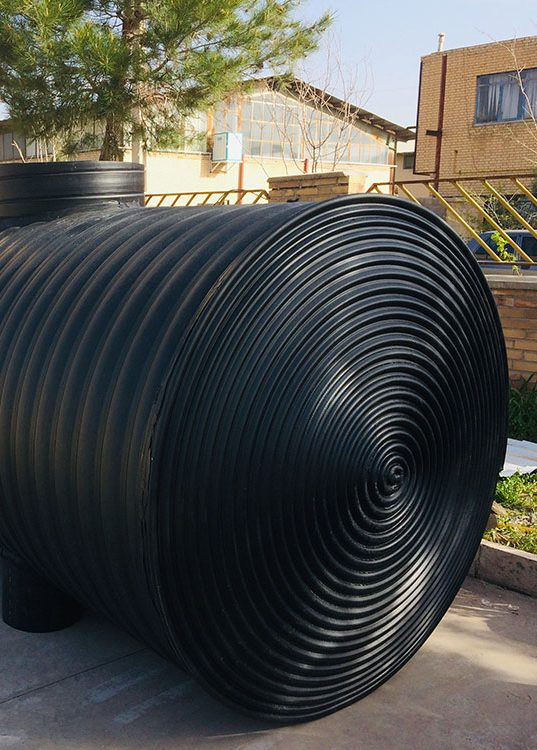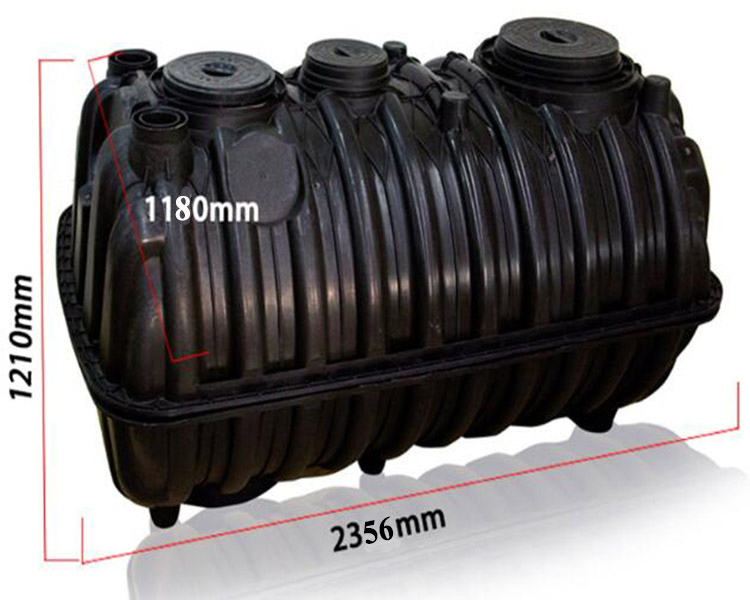septic tank
What is a septic tank?
In simple words, a septic tank is a device to purify the sewage that comes out of residential units so that when it goes into the sewage well, it does not cause the holes of the well to be blinded.
Septic tank is a pre-treatment unit that reduces the load of sewage pollution by 25-30%. Septic tank is the simplest and most widely used unit used in wastewater treatment, especially sanitary-human wastewater.
A septic tank is a tank in which wastewater is treated with the help of processes such as sedimentation, flotation and biological treatment. Physical and biological processes are the main processes that treat wastewater in a septic tank. These processes mainly include sedimentation, flotation and biological anaerobic processes, each of which reduces a part of the pollution load.
Septic tanks are widely used in residential and villa units, residential and office complexes, civil and construction workshops, manufacturing and industrial factories, hotels, restaurants, and entertainment and sports complexes.

Specifications of septic tank
A septic tank is a tank in which wastewater is treated with the help of processes such as sedimentation, flotation and biological treatment. Physical and biological processes are the main processes that treat wastewater in a septic tank. These processes mainly include sedimentation, flotation and anaerobic biological processes, each of which reduces a part of the pollution load.
Septic tank dimensions
The dimensions of the septic tank manufactured by Sable Lulu Navin Company are variable and it is possible to produce it in different volumes.
The main components of the septic tank are:
1. The sewage inlet system into the first part of the septic tank: it consists of a single-walled or double-walled polyethylene pipe and an inlet baffle that is installed in a three-way manner.
2. The first part of the septic tank: it has the largest volume of the septic tank (66% of the volume of the septic tank). Most of the suspended solids settle at the bottom of this area.
3. Separating wall: The middle baffle or the separating wall prevents sludge, fat and floating oils from entering the clarification tank (the second part of the septic tank).
4. Clarification tank: This tank includes 33% of the total volume of the septic tank. Dissolved organic matter in the effluent of the first part of the septic tank is decomposed during the anaerobic process; And most of the sediments in this part are the carcasses of microorganisms.
5. Bio-gas discharge pipe: through this pipe, the gases produced from the anaerobic wastewater treatment processes (mainly methane) are removed from the septic tank. Another name for this tube is air vent. The diameter of the vent pipe is basically 63 mm.
6. Sewage outlet system: It includes the outlet pipe and the septic tank. The diameter of the outlet pipe from the septic tank must not be smaller than the diameter of the inlet pipe of the septic tank.
7. Siphon system: includes a siphon at the outlet of the septic tank and to prevent fat from leaving the septic tank into the absorption well or urban sewer, as well as a siphon at the inlet in order to prevent the return of the unpleasant smell of sewage when it is not used for a long time (days is closed).
Carogate pipe is one of the pipes that is widely used in the construction of septic tank because the construction method of both is almost in the same direction.
Please refer to the new tube style catalog, page 7 for more information.

Advantages of septic tank
The many advantages of polyethylene have caused its use in the construction of septic tanks to expand day by day. Ease of operation and high efficiency are the main features of the polyethylene septic tank.
• Complete isolation and no smell
• No water leakage and environmental pollution
• Ease of operation and sludge discharge through sludge inspection and discharge valves
• The possibility of burying underground with the aim of gravity transfer of wastewater to the septic tank and preventing the occupation of useful spaces
• Providing adequate adjustment or reduction of fluctuations in organic load changes to prevent shock load
• Impact on biological systems and providing constant flow for treatment plant units
• Provision of continuous feed for biological systems
• Pre-aeration of sewage
• Reducing the consumption of energy and chemicals for wastewater neutralization
• Resistance to ultraviolet rays due to the use of materials (Anti-UV)
• High resistance to corrosion and chemicals
• The construction of the walls and the possibility of being buried and the long life of the polyethylene septic tank
• Light weight and ease of transportation
• Portable and easy to move even a few years after initial installation
• High speed in construction, installation and commissioning
• Suitable for fortress lands or lands that have very little absorption power
• Can be buried (does not occupy a place)
• Not using electromechanical devices (as a result, it does not require continuous operation or maintenance)
• Affordable due to the price of the septic tank
Application of polyethylene septic tank
At present, due to the replacement of the culture of living in houses all over the world, it has caused the wastewater of residential, office, commercial, industrial complexes, etc. to increase so much that the absorption well and anaerobic bacteria in it have enough opportunity to carry out chemical reactions on do not have solid sewage and its conversion to liquid sewage. Therefore, due to the research done by scientists and environmentalists, a device called septic tank was invented and introduced to mankind. The main plan of the septic tank is to take all the solids from the incoming sewage to the septic system and deliver a cloudy and smelly liquid.
Septic tank has been widely used in various domestic, sanitary and industrial sectors. Some of the main uses of septic tanks are:
• Pre-treatment and preliminary treatment of sanitary sewage of residential units, commercial and office complexes, hotels and restaurants due to municipal laws and environmental protection organization
• Removal of sedimentable particles, fat and oils in the wastewater of restaurants and dining halls to prevent the absorption well from filling up quickly and clogging of pipes due to the accumulation of fat and large sedimentable particles.
• Balancing and pumping wastewater in wastewater treatment systems

Do you need a consultant in the field of buying a polyethylene septic tank?
By sending a request through the online consultation form, the sales experts of the new pipe style will contact you as soon as possible.
Polyethylene pipe raw materials
Polyethylene septic tanks must be resistant to wear and corrosion. Also, these septic tanks should be easy to install and flexible and should not have any leaks. By producing these septic tanks with HDPE material, all these advantages will be obtained.
The raw materials used in the production of double-walled plastic pipes are natural (virgin) polyethylene or polyethylene containing carbon black in grades PE 100 or PE 80.
Let’s take a quick look at some of the properties and sources of HDPE high density polyethylene materials:

The designations PE80 and PE100 are based on the long-term strength of the respective materials, known as minimum required strength (MRS) according to ISO 12162.

Chemical resistance
Pipes made from HDPE materials are generally resistant to chemicals commonly found in municipal wastewater.
The maximum operating temperature for PE 100 in different environments is as described by Dale.

The reliable suppliers of HDPE grade PIPE EXTRUDE materials in the country are as follows:

Septic tank price
محاسبه قیمت سپتیک تانک با توجه به ابعاد آن و مشخصات مواد بکار رفته و گرید مواد و قطر و وزن تانک و با توجه به جدول استانداردهای این محصول تعییین میگردد.
لیست قیمت سپتیک تانک و همچنین قیمت سپتیک تانک پلی اتیلن براساس قیمت فروش مواد اولیه در بورس کالا با احتساب هزینه تولید و حمل و تحویل درب کارخانه و بر اساس گریدهای مواد اولیه به صورت کیلوگرم و یا بر اساس متر محاسبه و اعلام میگردد.
سبک لوله نوین شما را در انتخاب مقرون به صرفه ترین حالت ممکن کمک خواهند کرد.
Carrogate polyethylene pipe buying guide
Calculating the capacity of the septic tank plays an essential role in purchasing a septic tank and estimating its cost.
Septic tanks are usually used for sanitary sewage. Based on the existing standards, the capacity of the septic tank is considered to be equal to the volume of wastewater produced daily. Therefore, in order to determine the required capacity of the septic tank, you must first calculate the volume of wastewater produced daily. The volume of sanitary sewage usually directly depends on the number of people covered.
Do you need a consultant in the field of buying a polyethylene septic tank?
By sending a request through the online consultation form, the sales experts of the new pipe style will contact you as soon as possible.
Or call the following numbers:
+98-87-33362300
+98-9184068536

